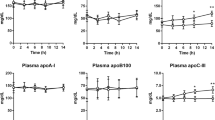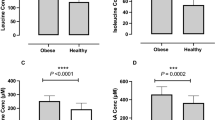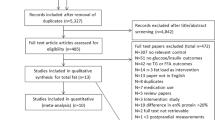Abstract
Objective: To investigate whether the postprandial changes in plasma triacylglycerol (TAG), nonesterified fatty acids (NEFA), glucose and insulin concentrations in young men were the same if an identical meal was fed at breakfast and lunch, and if the response to lunch was modified by consumption of breakfast.
Methods: In two trials (1 and 2) healthy subjects (age 22±1 y, body mass index 22±2 kg/m2) were fed the same mixed macronutrient meal at breakfast at 08:00 h and lunch at 14:00 h. In the third trial, no breakfast was fed and the overnight fast extended until lunch at 14:00 h. Addition of [1,1,1-13C]tripalmitin to one meal in each trial was used to distinguish between endogenous and meal-derived lipids.
Results: The postprandial changes in TAG, NEFA and glucose concentrations were similar in trials 1 and 2. The change in plasma total TAG concentration was about two fold less (P<0.05) after lunch compared to breakfast. Postprandial NEFA suppression was the same after breakfast and lunch. Glucose and insulin responses were significantly greater following lunch suggesting decreasing insulin sensitivity during the day. Consumption of breakfast did not alter the postprandial total TAG or NEFA responses after lunch. Measurement of [13C]palmitic acid concentration showed that handling of TAG and NEFA from the meal was the same after breakfast and lunch, and was not altered by consumption of breakfast.
Conclusions: Overall, these data suggest that in young, healthy men regulation of plasma TAG from endogenous sources, principally VLDL, but not chylomicrons during the postprandial period leads to differences in the magnitude of lipaemic response when the same meal was consumed at breakfast or at lunch 6 h later.
This is a preview of subscription content, access via your institution
Access options
Subscribe to this journal
Receive 12 print issues and online access
$259.00 per year
only $21.58 per issue
Buy this article
- Purchase on Springer Link
- Instant access to full article PDF
Prices may be subject to local taxes which are calculated during checkout





Similar content being viewed by others
References
Barter PJ, Carroll KF & Nestel PJ (1971): Diurnal fluctuations in triglyceride, free fatty acids, and insulin during sucrose consumption and insulin infusion in man. J. Clin. Invest. 50, 583–591.
Bergeron N & Havel RJ (1996): Prolonged postprandial responses of lipids and apolipoproteins in triglyceride-rich lipoproteins of individuals expressing an apolipoprotein epsilon 4 allele. J. Clin. Invest. 97, 65–72.
Bjorkegren J, Packard CJ, Hamsten A, Bedford D, Caslake M, Forster L, Shepard J, Stewart P & Karpe F (1996): Accumulation of very large low density lipoprotein in plasma during intravenous infusion of a chylomicron-like triglyceride emulsion reflects competition for a common lipolytic pathway. J. Lipid Res. 37, 76–78.
Brown AJ & Roberts DC (1991): Moderate fish intake improves lipemic response to a standard fat meal. Arterioscler. Thromb. 11, 457–466.
Bulow J, Simonsen L, Wiggins D, Humphreys SM, Frayn KN, Powell D & Gibbons GF (1999): Co-ordination of hepatic and adipose tissue lipid metabolism after oral glucose. J Lipid Res. 40, 2034–2043.
Burdge GC, Wright P, Jones AE & Wootton SA (2000): A method for separation of phosphatidylcholine, triacylglycerol, non-esterified fatty acids and cholesterol esters from plasma by solid phase extraction. Br. J. Nutr. 84, 781–787.
Burdge GC, Jones AE & Wootton SA (2002): Eicosapentaenoic and docosapentaenoic acids are the principle products of α-linolenic acid metabolism in young men. Br. J. Nutr. 88, 355–363.
Burdge GC & Wootton SA (2002): Conversion of α-linolenic acid to eicosapentaenoic, docosapentaenoic and docosahexaenoic acids in young women. Br. J. Nutr. 88, 411–420.
Byrne CD, Brindle NP, Wang TW & Hales CN (1991): Interaction of non-esterified fatty acid and insulin in control of triacylglycerol secretion by Hep G2 cells. Biochem. J. 280, 99–104.
Carroll KF & Nestel PJ (1973): Diurnal variation in glucose tolerance and in insulin secretion in man. Diabetes 22, 333–348.
Cohen JC & Schall R (1988): Reassessing the effects of simple carbohydrates on the serum triglyceride responses to fat meals. Am. J. Clin. Nutr. 48, 1031–1034.
Cohn JS, McNamara JR, Cohn SD, Ordovas JM & Schaefer EJ (1988): Postprandial plasma lipoprotein changes in human subjects of different ages. J. Lipid Res. 29, 469–479.
Couillard C, Bergeron N, Prud'homme D, Bergeron J, Tremblay A, Bouchard C, Mauriege P & Despres JP (1998): Postprandial triglyceride response in visceral obesity in men. Diabetes 47, 953–960.
Dashti N & Wolfbauer G (1987): Secretion of lipids, apolipoproteins, and lipoproteins by human hepatoma cell line, HepG2: effects of oleic acid and insulin. J. Lipid Res. 28, 423–436.
de Bruin TWA, Brouwer CB, van Linde-Sibenius Trip M, Jansen H & Erkelens DW (1993): Different postprandial metabolism of olive oil and soybean oil: a possible mechanism of the high-density lipoprotein conserving effect of olive oil. Am. J. Clin. Nutr. 589, 477–483.
Durrington PN, Newton RS & Weinstein DB (1982): Effect of insulin and glucose on very-low-density lipoprotein triglyceride secretion by cultured rat hepatocytes. J. Clin. Invest. 70, 63–73.
Evans K, Kuusela PJ, Cruz ML, Wilhelmova I, Fielding BA & Frayn KN (1998): Rapid chylomicron appearance following sequential meals: effects of second meal composition. Br. J. Nutr. 79, 425–429.
Evans K, Burdge GC, Wootton SA, Clark ML & Frayn KN (2002): Regulation of dietary fatty acid entrapment in subcutaneous adipose tissue and skeletal muscle. Diabetes 51, 2684–2690.
Fielding BA, Callow J, Owen RM, Samra JS, Matthews D & Frayn KN (1996): Postprandial lipaemia: the origin of an early peak studied by specific dietary fatty acid intake during sequential meals. Am. J. Clin. Nutr. 63, 36–41.
Folch JL, Lees M & Sloane-Stanley GH (1957): A simple method for the isolation and purification of total lipids from animal tissues. J. Biol. Chem. 226, 497–509.
Frayn KN, Coppack SW, Fielding BA & Humphreys SM (1995): Co-ordinated regulation of hormone-sensitive lipase and lipoprotein lipase in human adipose tissue in vivo: implications for the control of fat storage and fat mobilisation. Adv. Enzyme Regul. 35, 163–178.
Frayn KN, Summers LKM & Fielding BA (1997): Regulation of the plasma non-esterified fatty acid concentration in the postprandial state. Proc. Nutr. Soc. 56, 713–721.
Frayn KN (1998): Non-esterified fatty acid metabolism and postprandial lipaemia. Atheroscler. 141(Suppl 1), S41–S46.
Friday KE, Srinivasan SR, Elkasabany A, Dong C, Wattigney WA, Dalferes E & Berenson GS (1999): Black–white differences in postprandial triglyceride response and postheparin lipoprotein lipase and hepatic triglyceride lipase among young men. Metabolism. 48, 749–754.
Georgopoulos A & Rosengrad AM (1989): Abnormalities in the metabolism of postprandial and fasting triglyceride-rich lipoprotein subfractions in normal and insulin-dependent diabetic subjects: effects of sex. Metabolism. 38, 781–789.
Grant KI, Marais MP & Dhansay MA (1994): Sucrose in a lipid-rich meal amplifies the postprandial excursion of serum and lipoprotein triglyceride and cholesterol concentrations by decreasing triglyceride clearance. Am. J. Clin. Nutr. 59, 853–860.
Harris WS & Connor WE (1980): The effects of salmon oil upon plasma lipids, lipoproteins and triglyceride clearance. Trans. Am. Physic. Assoc. 43, 179–184.
Harris WS, Connor WE, Alam N & Illingworth DR (1988): Reduction of postprandial triglyceridemia in humans by dietary n-3 fatty acids. J. Lipid Res. 299, 1451–1460.
Harris WS & Muzio F (1993): Fish oil reduces postprandial triglyceride concentrations without accelerating lipid-emulsion removal rates. Am. J. Clin. Nutr. 58, 68–74.
Jackson KG, Knapper JM, Zampelas A, Gould BJ, Lovegrove JA, Wright J & Williams CM (1995): Apolipoprotein B-48 and retinyl ester responses to meals of varying monounsaturated fatty acid contents. Atherosclerosis 115, S16.
Jarrett RJ & Keen H (1969): Diurnal variation of oral glucose tolerance: a possible pointer to the evolution of diabetes mellitus. BMJ 2, 341–422.
Jones AE, Stolinski M, Smith RD, Murphy JL & Wootton SA (1999): Effect of fatty acid chain length and saturation on the gastrointestinal handling and metabolic disposal of dietary fatty acids in women. Br. J. Nutr. 81, 37–43.
Karpe F, Steiner G, Olivecrona T, Carlson LA & Hamsten A (1993): Metabolism of tryglyceride-rich lipoproteins during alimentary lipaemia. J. Clin. Invest. 91, 748–758.
Karpe F (1997) Postprandial lipid metabolism in relation to coronary heart disease. Proc. Nutr. Soc. 56, 571–678.
Koutsari C, Karpe F, Humphreys SM, Frayn KN & Hardman AE (2001): Exercise prevents the accumulation of triglyceride-rich lipoproteins and their remnants seen when changing to a high-carbohydrate diet. Arterioscler. Thromb. Vascul. Biol. 21, 1520–1525.
Laker ME & Mayes PA (1984): Investigations into the direct effects of insulin on hepatic ketogenesis, lipoprotein secretion and pyruvate dehydrogenase activity. Biochim. Biophys. Acta 795, 427–430.
Lee A, Ader M, Bray GA & Bergman RN (1992): Diurnal variation in glucose tolerance. Diabetes 41, 750–759.
Lewis GF, O'Meara NM, Soltys PA, Blackman JD, Iverius PH, Druetzler AF, Getz GS & Polonsky KS (1990): Postprandial lipoprotein metabolism in normal and obese subjects: comparison after the vitamin A fat-loading test. J. Clin. Endocrinol. Metabol. 71, 1041–1050.
Lewis GF, Uffelman KD, Szeto LW & Steiner G (1993): Effects of acute hyperinsulinemia on VLDL triglyceride and VLDL apoB production in normal weight and obese individuals. Diabetes 42, 833–842.
Lewis GF, Zinman B, Uffelman KD, Szeto L, Weller B & Steiner G (1994): VLDL production is decreased to a similar extent by acute portal vs. peripheral venous insulin. Am. J. Physiol. 267, E566–E572.
Lovegrove JA, Brooks CN, Murphy MC, Gould BJ & Williams CM (1997): Use of manufactured foods enriched with fish oils as a means of increasing long chain n-3 PUFA intake. Br. J. Nutr. 78, 223–236.
Malmstrom R, Packard CJ, Watson TD, Rannikko S, Caslake M, Bedford D, Stewart P, Yki-Jarvinen H, Shepherd J & Taskinen MR (1997a): Metabolic basis of hypotriglyceridemic effects of insulin in normal men. Arterioscler, Thromb. Vascu. Biol. 17, 1454–1464.
Malmstrom R, Packard CJ, Caslake M, Bedford D, Stewart P, Yki-Jarvinen H, Shepherd J & Taskinen MR (1997b): Defective regulation of triglyceride metabolism by insulin in the liver in NIDDM. Diabetologid. 40, 454–462.
Malmstrom R, Packard CJ, Caslake M, Bedford D, Stewart P, Yki-Jarvinen H, Shepherd J & Taskinen MR (1998): Effects of insulin and acipimox on VLDL1 and VLDL2 apolipoprotein B production in normal subjects. Diabetes 47, 779–787.
Mann JI, Truswell AS & Pimstone BL (1971): The different effects of oral sucrose and glucose on alimentary lipaemia. Clin. Sci. 41, 123–129.
Nestel PJ, Carrol KF & Havenstein N (1970): Plasma tryglyceride response to carbohydrates, fats and caloric intake. Metabolism 19, 1–18.
Patsch JR, Miesenbock G, Hoferwieser T, Muhlberger V, Knapp E, Dunn JK, Gotto Am & Patsch W (1993): Relation of triglyceride metabolism and coronary artery disease. Atheroscler. Thromb. 12, 1336–1345.
Reaven GM, Hollenbeck C, Jeng C-Y, WU MS & Chen Y-DI (1988): Measurement of plasma glucose, free fatty acid, lactate and insulin for 24 h in patients with NIDDM. Diabetes 37, 1020–1024.
Rivera-Coll A, Fuentes-Arderiu X & Diez-Noguera A (1994): Circadian rhythmic variations in serum concentrations of clinically important lipids. Clin. Chem. 40, 1549–1553.
Romon M, Le Fur C, Lebel P, Edme J-L, Fruchart J-C & Dallongeville J (1997): Circadian variation of postprandial lipemia. Am. J. Clin. Nutr. 65, 934–9410.
Salhanick AI, Schwartz SI & Amatruda JM (1991): Insulin inhibits apolipoprotein B secretion in isolated human hepatocytes. Metabolism 40, 275–279.
Samra JS, Clark ML, Humphreys SM, MacDonald IA & Frayn KN (1996): Regulation of lipid metabolism in adipose tissue during early starvation. Am. J. Physiol. 271(Endocrinol. Metaboli. 34) E541–E546.
Schlierf G & Dorow E (1973): Diurnal patterns of triglycerides, free fatty acids, blood sugar, and insulin during carbohydrate-induction in man and their modification by nocturnal suppression of lipolysis. J. Clin. Invest. 52, 732–739.
Schneeman BO, Kottie L, Todd KM & Havel RJ (1993): Relationship between the responses of triglyceride-rich lipoproteins in blood plasma containing apolipoproteins B-48 and B-100 to a fat-containing meal in normolipidemic humans. Proc. Natl. Acad. Sci. USA 90, 2069–2073.
Shishehbor F, Roche HM & Gibney MJ (1998): The effect of acute carbohydrate load on the monophasic or biphasic nature of the postprandial lipaemic response to acute fat ingestion in human subjects. Br.J. Nutr. 80, 411–418.
Shumak SL, Zinman B, Zuniga-Guarjardo S, Poapst M & Steiner G (1988): Triglyceride-rich lipoprotein metabolism during acute hyperinsulinemia in hypertriglyceridemic humans. Metabolism 37, 461–466.
Service FJ, Hall LD, Westland RE, O'Brien PCO, Go VLW, Haymond MW & Rizza RA (1983): Effects of size, time of day and sequence of meal ingestion on carbohydrate tolerance in normal subjects. Diabetologia 25, 316–321.
Sniderman AD, Cianflone K, Arner P, Summers LKM & Frayn KN (1998): The adipocyte, fatty acid trapping and atherogenesis. Aterioscler. Thromb. Vascul. Biol. 18, 147–151.
Sparks JD, Sparks CE & Miller LL (1989): Insulin effects on apolipoprotein B production by normal, diabetic and treated-diabetic rat liver and cultured rat hepatocytes. Biochem. J. 261, 83–88.
Stampfer MJ, Krauss RM, Ma J, Blanche PJ, Holl LG, Sacks FM & Hennekens CH (1996): A prospective study of triglyceride level, low-density lipoprotein particle diameter, and risk of myocardial infarction. J. Am. Med. Assoc. 176, 882–888.
Swanson JE, Laine DC, Thomas W & Bantle JP (1992): Metabolic effects of dietary fructose in healthy subjects. Am. J. Clin. Nutr. 55, 851–886.
Topping DL & Mayes PA (1972): The immediate effects of insulin and fructose on the metabolism of the perfused liver. Changes in lipoprotein secretion, fatty acid oxidation and esterification, lipogenesis and carbohydrate metabolism. Biochem. J. 126, 295–311.
Vogelberg KH, Gries FA & Moschinski D (1978): Heptic production of VLDL triglyceride: dependence of portal substrate and insulin concentration. Hormone Metabol. Res. 12, 688–694.
Weintraub MS, Zechner R, Brown A, Eisenberg S & Breslow J (1988): Dietary polyunsaturated fats of the omega-6 and omega-3 series reduce postprandial lipoprotein levels. J. Clin. Invest. 82, 1884–1893.
Williams CM, Moore F, Morgan L & Wright J (1992): Effects of n-3 fatty acids on postprandial triglyceride and hormone concentrations in normal subjects. Br. J. Nutr. 68, 655–666.
Yahia N, Songhurst C & Sanders TAB (1996): Effect of different patterns of fat intake on postprandial lipaemia and factor VII coagulant activity. Proc. Nutr. Soc. 55, 227A (abstract).
Zampelas A, Peel AS, Gould BJ, Wright J & Williams CM (1994a): Polyunsaturated fatty acids of the n-6 and n-3 series: effects on postprandial lipid and apolipoprotein levels in healthy men. Eur. J. Clin. Nutr. 48, 88–96.
Zampelas A, Culverwell CC, Knapper JME, Jackson K, Gould BJ Wright J & Williams CM (1994b): Olive oil and postprandial lipaemia: a study on the effect of meals of different olive oil content on postprandial lipid levels in healthy men. Proc. Nutr. Soc. 45, 164A (abstract).
Acknowledgements
We thank Mr C Gelauf for preparation of specimens for GC-C-IRMS and Dr P Wood, Department of Clinical Chemistry, Southampton Hospital University Trust, Southampton, UK for measurement of plasma insulin concentrations.
Author information
Authors and Affiliations
Corresponding author
Rights and permissions
About this article
Cite this article
Burdge, G., Jones, A., Frye, S. et al. Effect of meal sequence on postprandial lipid, glucose and insulin responses in young men. Eur J Clin Nutr 57, 1536–1544 (2003). https://doi.org/10.1038/sj.ejcn.1601722
Received:
Revised:
Accepted:
Published:
Issue Date:
DOI: https://doi.org/10.1038/sj.ejcn.1601722
Keywords
This article is cited by
-
Day-to-day regularity in breakfast consumption is associated with weight status in a prospective cohort of women
International Journal of Obesity (2020)
-
Dietary fatty acid metabolism of brown adipose tissue in cold-acclimated men
Nature Communications (2017)
-
Using a lipidomics approach for nutritional phenotyping in response to a test meal containing gamma-linolenic acid
Metabolomics (2016)
-
Hepatic miR-378 targets p110α and controls glucose and lipid homeostasis by modulating hepatic insulin signalling
Nature Communications (2014)
-
Time-of-day and nutrient composition of eating occasions: prospective association with the metabolic syndrome in the 1946 British birth cohort
International Journal of Obesity (2013)



